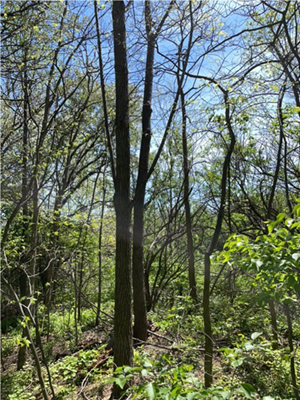SHA Bay Restoration Strategies
To reduce the primary pollutants impairing waters of the Chesapeake Bay (i.e., nitrogen, phosphorus and sediment), the Maryland Department of Transportation State Highway Administration (SHA) implements various water quality improvement strategies, known as Best Management Practices (BMPs), that have been approved by experts at the Chesapeake Bay Program (CBP) and the Maryland Department of the Environment (MDE) for that purpose. Some of the common SHA restoration strategies are described below. Additional information about approved BMP types can be found on both
MDE’s and
CBP’s websites.
Forest Planting
Since 2010, SHA has planted and ensured survival for more than 120,000 trees at more than 850 planting sites across Maryland. Implementing Forest Planting BMPs in urban and suburban areas provides a host of environmental benefits, including reduced stormwater runoff, improved local water quality, cooling from canopy shading, habitat for wildlife and trapping of air pollution. The Tree Solutions Now Act of 2021 set forth an ambitious statewide carbon mitigation objective to plant and sustain maintenance of five million native trees across Maryland by the close of Calendar Year 2031. The MDE was charged with coordinating the tracking and implementation of this tree planting goal with leadership support from the Maryland Department of Transportation (MDOT). To learn more, visit MDE’s website to review the
Final Plan for Growing 5 Million Trees in Maryland and SHA’s associated contributions.
 SHA Forest Planting BMP site
SHA Forest Planting BMP site
Conservation Landscaping
Conservation landscaping is a term that describes the practice of converting managed turf/grass areas into meadow (i.e., consisting predominately of tall grasses and perennial wildflowers). This BMP type provides habitat for birds and pollinators, can hold rainfall and improve the quality of stormwater runoff, especially when draining from adjacent, hard surfaces. Establishing and maintaining new meadow areas is also a primary goal of the
SHA Pollinator Habitat Plan.
SHA Conservation Landscaping BMP project in Howard County, MD
Outfall Stabilization
Storm drains carry stormwater to structures known as ‘outfalls’ that transfer stormwater from pipes to local waterways. Due to increasing development and frequency of extreme storms in Maryland, older outfalls are increasingly unable to drain stormwater to local waterways without triggering erosion. For this reason, outfall areas are commonly considered “hotspots” for sediment (i.e., soil) pollution to the local waterways and the Chesapeake Bay. Outfall Stabilization BMPs slow or stop additional erosion. Since Outfall Stabilization BMPs seek to stop further erosion before it happens, they also prevent outfall collapse that can be caused by sediment erosion. Collapsed outfalls require expensive maintenance or replacement by SHA. Since 2017, SHA has implemented 31 outfall stabilization BMPs that have prevented an estimated 2,850 tons of sediment pollution from entering local waterways and the Bay. These BMPs also saved Maryland taxpayers millions of dollars in avoidable maintenance cost.
To incentivize greater implementation of Outfall Stabilization BMPs throughout Maryland, SHA worked with MDE and CBP to develop a process for estimating the total amount of pollution prevented by the practice. In 2019, MDE authorized SHA and other government agencies to use this process, referred to as “Protocol 5,” to earn restoration credits from Outfall Stabilization BMPs. To learn more about Protocol 5, see the CBP expert panel report linked below:
Recommendations for Crediting Outfall and Gully Stabilization Projects in the Chesapeake Bay Watershed | Chesapeake Stormwater Network
SHA Outfall Stabilization BMP project in Montgomery County, MD
Stream Restoration
Stream Restoration BMPs seek to improve water quality by reducing nutrient (e.g., nitrogen and phosphorus) and sediment pollution caused by erosion of stream banks and stream channels. These projects restore eroding stream banks and stream channels to more natural water flow patterns. This reduces the chance of further erosion during future storms. Since 2010, SHA has implemented 57 Stream Restoration BMPs that have prevented erosion and resulting nutrient and sediment pollution along more than 45 miles of Maryland streams. SHA will inspect and manage its Stream Restoration BMPs into the future so they continue to minimize erosion and associated pollution downstream to the Chesapeake Bay.
Stream restoration along southbound lane of MD210 in Prince George’s County.